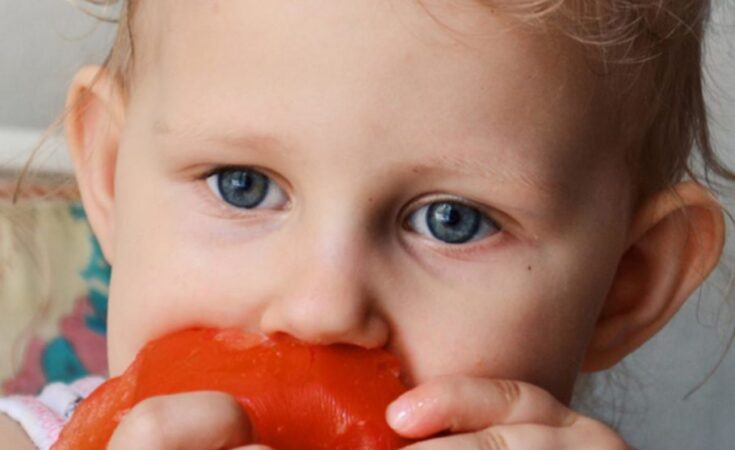Tomato is botanically a fruit and a versatile food used in several culinary preparations worldwide (1). Besides adding color and flavor, tomatoes offer vital micronutrients and bioactive compounds, such as vitamin C and lycopene, which promote health. Thus, you may consider adding tomatoes to your baby’s weaning diet (2).
But tomatoes are acidic and may cause acid reflux and rashes around the mouth or buttock (diaper rash). Therefore, is feeding tomatoes safe for babies? Also, what is the right age when you can feed tomato and tomato-based dishes to your baby?
This post answers all your queries, gives you an insight into the possible health benefits of tomatoes, and provides information about precautions to take while feeding tomatoes to babies.
When To Introduce Tomatoes To Baby?
Most babies can eat well-cooked tomatoes from the age of six months.
You can feed your baby steamed or boiled tomatoes (without skin) in mash or puree form. Removing peel is essential for younger babies as it’s tougher to digest. Besides, it can stick to the baby’s mouth and cause gagging. Therefore, feeding de-skinned tomatoes to a baby who has just started eating solids is advisable.
Once they develop the taste and digestibility for tomatoes, you can feed them roasted, grilled, sautéed, braised, and oven-dried tomatoes. You can use tomatoes to prepare several tomato-based dishes, such as tomato and vegetable sauce, tomato soup, and tomato curry. Also, you can add tomatoes to other soups, savory porridges, stews, and curries, to feed tomatoes to your baby in different ways.
Nutritional Value Of Tomatoes
There are thousands of tomato varieties, and each type is suitable for a specific purpose. For instance, Caprese tomatoes are suitable for salads, whereas red beefsteak tomatoes are ideal for sauces and dips (3).
The nutritional composition of different tomato varieties varies slightly. But, on average, feeding a cup (240g) of red, ripe, cooked tomato can offer the following nutrients to the baby against their recommended intakes (4) (5).
| Nutrients | Amount | AI (7-12 months) |
|---|---|---|
| Water | 226g | – |
| Fiber, total dietary | 1.68g | – |
| Iron, Fe | 1.63mg | 11 (RDA) |
| Magnesium, Mg | 21.6mg | 75mg |
| Phosphorus, P | 67.2mg | 275mg |
| Potassium, K | 523mg | 860mg |
| Sodium, Na | 26.4mg | 370mg |
| Vitamin C, total ascorbic acid | 54.7mg | 50mg |
| Folate, total | 31.2µg | 80µg |
| Choline, total | 16.6mg | 150mg |
| Vitamin A, RAE | 57.6µg | 500µg |
*AI = Adequate intake – nutrient level assumed to ensure nutritional adequacy
Sources: U.S. Department of Agriculture and Dietary Guidelines for Americans 2020-2025
Possible Health Benefits Of Tomatoes
Tomatoes have a promising nutritional composition that can benefit human health. Here is a brief overview of some of the benefits your baby could reap by consuming tomatoes as a part of a well-balanced weaning diet.
- Facilitates physiological functions: Tomatoes contain several micronutrients, such as potassium, vitamin A, phosphorus, magnesium, choline, and folate. Babies require these nutrients to perform various physiological functions. For instance, vitamins aid proper vision, skin, and immune system development (6). Choline helps in brain development, and magnesium is vital for nerve, muscle, and enzyme function (7) (8).
- Supports digestive health: Tomato is a juicy fruit made of more than 94 percent of water (4). Besides, it contains dietary fiber and naringenin, a flavonoid that may combat constipation. Thus, you can feed tomatoes to your baby as a part of a well-balanced diet to boost their digestive health (9).
- Promotes overall health: Vitamin C, flavonoids (naringenin and lutein), carotenoids (lycopene and beta-carotene), phenolic acids, and glycoalkaloids (tomatine) are some bioactive phytochemicals found in ripe tomatoes. According to several recent studies, these compounds have antioxidant and anti-inflammatory properties, boosting immunity and conferring long-term health benefits (10) (11).
Besides these benefits, vitamin C in tomatoes can enhance iron absorption, which is crucial for proper brain development and growth.
How To Select And Store Tomatoes?
Appropriate selection and storage of tomato are pertinent to ensure tomato’s safe ingestion.
Selecting tomatoes
- Smell tomatoes first. Fresh tomatoes have a neutral to pleasant aroma that will not be present in stale or old tomatoes.
- Buy tomatoes that look clean and fresh. They should be bright-colored (red, yellow, or green) and free from black pits or blemishes. Vine-ripened tomatoes are best, although they are seasonal.
- The tomato should feel firm to touch but not hard. Ideally, it should feel plump when you press its skin.
- Avoid tomatoes that have cuts or bruises with the juice oozing out from them.
- If you are buying canned tomatoes, check the product label carefully and buy low-sodium tomatoes. Ensure the can is sealed correctly and is dent- and rust-free.
Storing tomatoes
- If you purchase unripe tomatoes, store them on the counter, away from direct sunlight, so that they may ripen.
- Don’t store unripened tomatoes in the refrigerator, as refrigeration slows down the ripening process.
- You can keep tomatoes with ethylene-producing fruits, such as bananas, in a paper bag to hasten their ripening.
- Once tomatoes are ripe, they can stay at room temperature for no more than two to three days, depending on the room temperature.
- Avoid storing ripened tomatoes in the refrigerator as their flesh turns mushy.
- Never store cut tomatoes in open containers as they can absorb odor from other veggies kept beside them. Also, cut/sliced tomatoes are a breeding ground for microbes that raise the risk of food poisoning.
- If you have to store cut tomatoes, better keep them in an airtight, BPA-free plastic or glass container.
Age-Appropriate Ways To Feed Tomatoes To Babies
After proper selection and storage, safe ingestion of tomatoes relies on the right way to feed them. Here’s how you should feed tomatoes to babies as per their age.
- For six-month-olds: Tomato’s skin is tough to digest for babies. Therefore, always feed de-skinned, well-cooked tomato mash or puree to young babies. Ensure the puree or mash is lump-free to avert choking risk. You can give raw, de-skinned, quartered tomato slices/wedges, which the baby can easily hold and eat. Raw Roma and beefsteak tomatoes are a good choice for young babies as they are juicy and have a sweet-tangy taste.
- For nine-month-olds: As the baby grows, you may leave the skin on and give one-inch-sized, raw tomato pieces as finger foods to your baby. You can provide quartered pieces of cherry or grape tomatoes to your baby after removing any seeds. Most babies by nine months of age can nibble on tomato slices comfortably. However, if you feel the tomato’s skin is still bothering your baby, you can remove it or serve peeled, cooked tomatoes.
- For 12-month-olds: Most 12-month-old babies have a refined pincer grasp and can pick small tomato pieces using a fork. You can provide slightly thick yet small, raw tomato pieces to the baby for self-feeding. Since babies now have teeth, they may most likely have no issues with the tomato skin. Cherry or grape tomatoes still need to be quartered as they remain a choking hazard for babies under four years of age (12).
Precautions To Take While Feeding Tomatoes To Babies
Tomato consumption is seldom a problem. Nevertheless, it is essential to observe some precautions while feeding tomatoes to your baby.
- Introduce de-skinned, well-cooked tomato to babies in a puree or mash form. Once the baby adjusts to tomato’s digestibility, add tomato to other veggies and dishes, such as curries. You can also make tomato sauce and dip that the baby can consume with sandwiches and other finger foods.
- Follow a “three to five days wait” rule before introducing any new food to your baby. Adhering to this rule is essential to see if your baby is experiencing any discomforts, such as allergy or intolerance, after ingesting tomatoes.
- Feed no more than a teaspoon of tomato puree or mash to the baby initially. Once the baby seems comfortable digesting tomatoes, increase the quantity to a tablespoon or two gradually.
- Discontinue feeding tomato for the time being if the baby shows signs of discomfort and reintroduce tomato after some time. Some babies could be intolerant to raw tomatoes. Thus, try feeding cooked tomatoes. Most babies digest cooked tomatoes comfortably. If cooked tomatoes still bother the baby, stop feeding tomatoes and consult a pediatrician.
- Tomato allergy isn’t common, but it’s possible. An individual allergic to tomatoes can develop an allergic reaction after touching (contact dermatitis) or ingesting a tomato. Some of the common signs that you may notice in an allergy episode are wheezing, cough, itchy skin rashes (hives), abdominal discomfort, and vomiting (13).
- Consult a doctor or healthcare provider before feeding tomatoes to your baby. It’s vital if the baby is allergic to any other vegetable of the nightshade family, such as potato, chilies, peppers, and aubergine/eggplant. Also, tomatoes can have cross-reactivity to peach, nuts, and melons. Therefore, seek expert guidance, especially if the baby has a family history of food allergy (14).
Tasty Tomato Recipes For Babies And Toddlers
Here are some recipes that you can make different varieties and forms of tomatoes for your baby.
1. Tomato puree (6+ months)
You will need:
- 2 Roma tomatoes
- 1tsp mint leaves (chopped)
- ⅛ tsp pepper powder
How to make:
- Put tomatoes in a stockpot and fill it with water.
- Cover the stockpot with a lid and let the tomatoes boil over medium heat (blanching) for about ten minutes or until the tomatoes turn tender.
- After ten minutes, turn off the heat and put the tomatoes aside on a plate to cool.
- Now, peel off the tomatoes’ skin and put the tomatoes into a blender.
- Add chopped mint leaves and pepper into the blender and blend the tomatoes into a smooth puree. Ensure no lumps are left.
- Sieve the mixture into a bowl and feed the puree to your baby.
2. Tomato soup (8+ months)
You will need:
- 1 tomato
- 1 carrot (peeled)
- 1 cup water
- 1tbsp onion (chopped)
- 1tsp unsalted butter
- ½ tsp garlic (finely chopped)
- ¼ tsp cumin seeds
- Pinch of black pepper powder
How to make:
- Heat butter in a pressure cooker on medium heat.
- As the butter melts, add cumin seeds. Once the cumin seeds begin crackling, add onions and garlic. Stir it for two to three minutes.
- Then, add carrot, tomato, and black pepper powder. Add water and bring the mixture to a boil.
- Cover the pressure cooker with a lid and cook the ingredients on a medium flame for three whistles.
- After the third whistle, turn off the flame and put the pressure cooker aside to let the pressure release.
- Transfer the pressure-cooked mixture into a blender and blend well into a lump-free, smooth liquid.
- Strain the liquid using a sieve into a bowl and feed the baby. Alternatively, you can feed the baby unstrained soup if they aren’t bothered by its chunky texture.
3. Tomato omelet (10+ months)
You will need:
- 1 egg (whisked)
- 2-3 cherry tomatoes (chopped into small pieces)
- 1tbsp red onion (finely chopped)
- 1tsp coriander (chopped)
- 1tsp olive oil
- ⅛ tsp herbs mix
How to make:
- Heat olive oil in a skillet over low heat.
- Meanwhile, put all the ingredients into a bowl and whisk well.
- Pour the mixture onto the skillet and cook on both sides until the omelet turns golden brown.
- Once done, turn off the heat and transfer the omelet to a plate.
- Serve the omelet with crusted bread to your baby for self-feeding. You can add bell peppers, mushrooms, and corn to make this omelet colorful, flavorful, and wholesome.
4. Pasta with tomato sauce (12+ months)
You will need:
- 1 cup beefsteak tomatoes (chopped)
- ½ cup cooked spaghetti pasta
- 1 red onion (finely chopped)
- 1 garlic clove (minced)
- 2tbsp tomato puree
- 1tbsp fresh basil (chopped, for garnish)
- 2tsp mixed herbs (dried)
- 1tsp olive oil
How to make:
- Heat the olive oil in a saucepan over medium heat. As the oil warms, add chopped onion and cook for three to four minutes, until soft.
- Next, add minced garlic, and cook the mixture for another minute. Then, add chopped tomatoes, tomato puree, and mixed herbs.
- Mix everything well and let the mixture simmer for 15 minutes or until the sauce thickens, stirring occasionally.
- Once the sauce is done, pour it over the cooked spaghetti and garnish the dish with fresh basil.
- Serve warm to your baby with half a cup of lemonade to relish this delicious tomato-based dish for lunch.
Tomato is a flavorful culinary vegetable that can add flavor, texture, and color to a dish. Additionally, it can confer long-term health benefits that can boost a baby’s overall health. Babies can consume tomatoes from six months of age in mash or puree form. As they grow older, they can relish various tomato-based dishes across meals.
References:
MomJunction’s articles are written after analyzing the research works of expert authors and institutions. Our references consist of resources established by authorities in their respective fields. You can learn more about the authenticity of the information we present in our editorial policy.



































